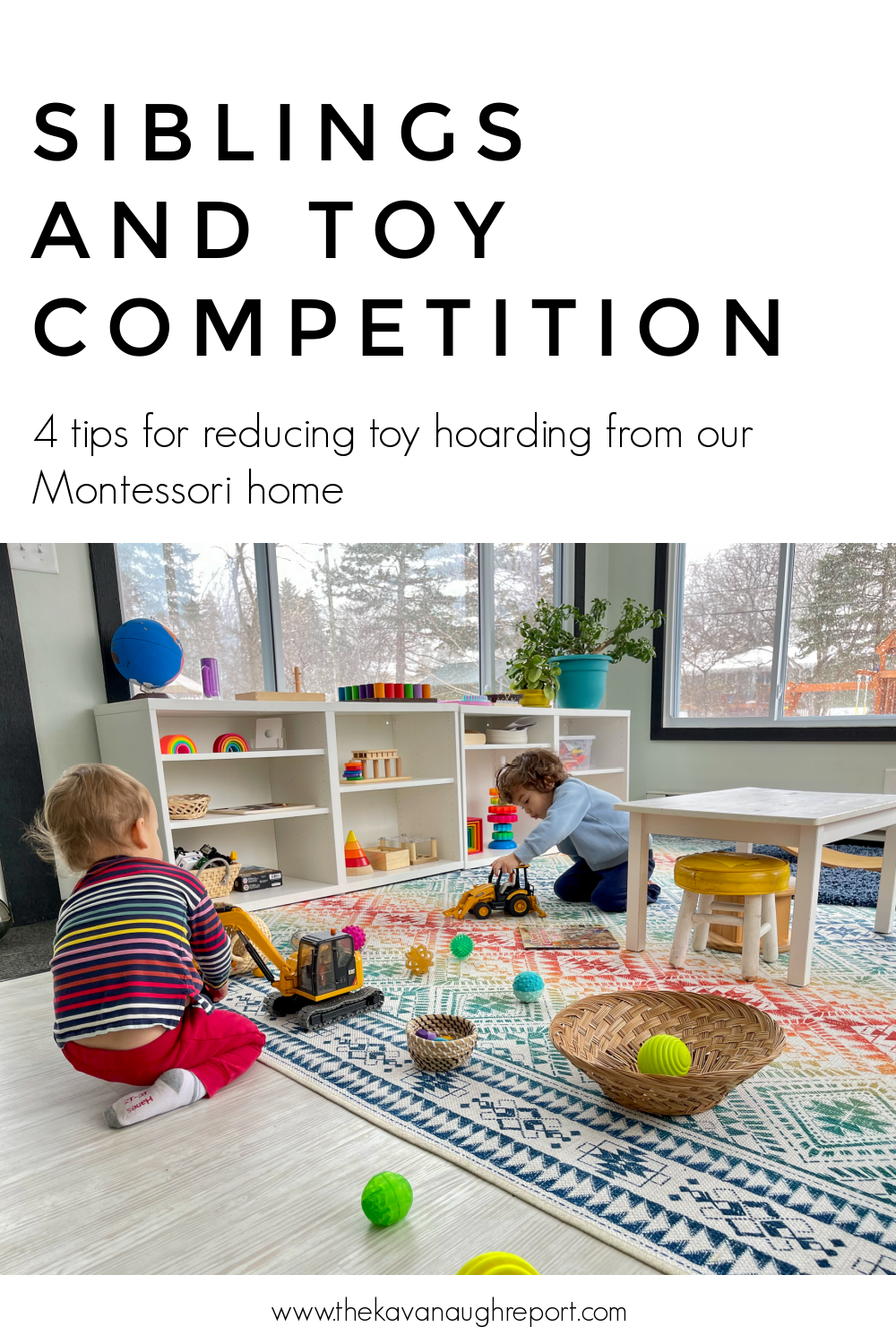“That’s my toy!” “You can’t use it!” “Give it to me.” “She’s not sharing!” I’ve been getting a lot of questions about how we handle toy competition, sharing, and fairness lately. And, I totally get why. Bickering, fighting, and whining from big and little kids is no fun for anyone. It can make your house feel like a competition and you feel like a referee.
Our house is not immune to these squabbles between siblings. When you have five kids, I'm coming to accept that you pretty much always have someone who is having some big or hard feelings about something. And, often, those feelings are coming because of one of their siblings. However, as a Montessori family we have set some boundaries around materials that have helped to keep toy competition and hoarding and sharing of materials to a minimum.
4 Ways to Reduce Toy Competition Among Siblings
First, what do I mean by "toy competition and hoarding?" Well, I'm talking about those times where there is a material on the shelf and it may be placed there for one child but another child wants to use it. So, in my case, maybe I place a toy on the shelf for Teddy but Gus wants to use it. Gus tries to use it and Ted gets angry, for example. Who gets the toy? Is Gus allowed to use it?
For toy hoarding, I mean those times when a toy is gifted to one child, can that child demand that no one else is allowed to use it? If Nora gets something for her birthday, can she tell others that they cannot use it? Can children hoard toys for themselves? Or do we force that child to share?
Here are some of the limits we set in our house to try and minimize these issues:
- Ownership: We do NOT emphasize ownership when it comes to toys and materials. Yes, someone might have gotten a particular toy for their birthday, but that doesn't mean it's their toy. It's a toy that was brought into our house in celebration of them, but it is not specifically something they control. Therefore, we have less "that's my toy, you can't use it!"
When there is less ownership, and more of a collective spirit, I've noticed we don't get as much competition and hoarding. Yes, Nora might have gotten something for her birthday, but everyone gets to be excited because they all know they will get the chance to use it. - Availability: Any toy that is available on the shelves (no matter who I had in mind when I put it there) is available to any child that is "ready" for that work. So for example, I would never tell Gus, "that's Teddy's work, choose something of yours" or anything like that. Generally, I will say things like "I thought you might like this material, can I show it to you?"
Then I trust that children will gravitate to the work that they are meant to have. If someone is always choosing work that was meant for a younger child (or an older one) that is a sign to me that the materials I'm placing for that child might be missing the mark. I need to use that a sign for me to make changes, not force the child to change what they are trying to pick.
- Readiness: A child is ready for a particular work when they can use it safely and have been shown how to use it. Generally this means that work for younger kids is available to an older one. But, a younger child cannot always use the work for older children. This takes setting limits - often through how we set up the environment but also through consistent modeling - to ensure that younger children and the materials are kept safe.
Safety is always my biggest concern in these moments - safety for the child, but also for the material itself. If a material will be damaged because a child just can't keep it safe (a toddler using something delicate, for example) then it's not fair for everyone else to let that child use and break the material. Nor, can I let a child hurt themselves (mouth LEGOs, for example) just because they want to use something. - Sharing: We NEVER force a child to share something they are using in our home. The child who is using the material first, can use the material until they feel done with it. Once it has been returned to the shelf, another child can choose the work. I will never step in and say "share that with your brother, you've had it long enough" or anything like that.
Forced sharing increases a feeling of scarcity among children. It can make them more possessive because they never know when they will need to give up the thing they are working with. Instead, but allowing children to use something until they are done, they don't feel the need to hoard or compete. The waiting child knows they will eventually get a turn. That doesn't mean waiting is always easy!
Even with these four limits in place, we do still see occasional bouts of toy competition and hoarding. If it's with the younger kids (under 6ish) then I try and set the limits myself and help children through big feelings. If it's with my second plane (6+) kids then I encourage and mediate cooperation and conflict resolution. I want them to start to feel empowered to create their own play dynamics, and find cooperation with their siblings. Often they will be able to think of (on their own) ways to play together with the material.
Do you see toy competition or hoarding in your home? How do you address it?





